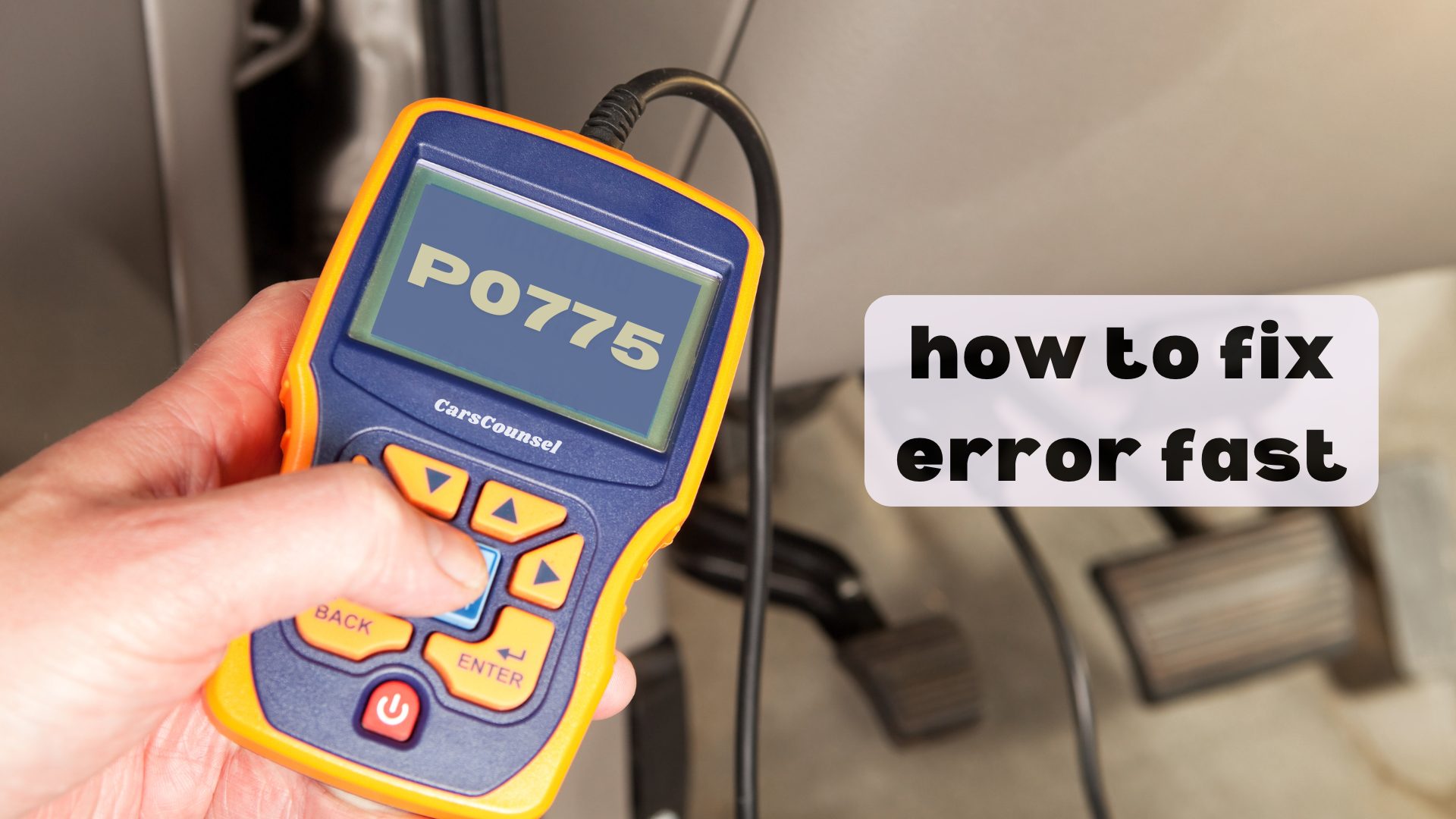Fixing a P0775 code might seem tricky, but it’s doable if you follow some simple steps.
First, use an OBD-II scanner to confirm the trouble code and check for any other related trouble codes.
Look at your transmission fluid; it should be clean and at the right level because low or dirty fluid can cause solenoid issues.
Then, use a multimeter to test the solenoid valve and its electrical connections.
If you find any problems, replace the solenoid and refill the transmission with the correct fluid.
Finally, clear the codes and take your car for a test drive to make sure everything is working fine.

Quick Navigation
Key Takeaways
- Connect an OBD-II scanner to confirm the P0775 error code and get more detailed information.
- Check and replace the transmission fluid if it’s low or dirty.
- Inspect and test the solenoid valve for any wear, damage, or clogs, and replace it if needed.
- Check wiring and electrical connections for any issues using a multimeter to make sure the solenoid is getting the right signal.
Understanding P0775
Understanding the P0775 code is important because it signals a problem with the transmission’s pressure control solenoid valve B, which directly affects how your vehicle shifts gears.
This code usually shows up in automatic transmissions, where solenoids are crucial for controlling hydraulic pressure to ensure smooth gear changes.
The pressure control solenoid valve B manages the fluid pressure needed for shifting gears. When it fails, you might notice rough or delayed shifting, and your car could even go into limp mode.
Solenoids act like electronic switches, and any issue with them can seriously mess up your transmission.
Diagnosing and fixing this problem quickly will help keep your transmission running smoothly and prevent further damage to your vehicle.
Common Causes
Several things can trigger the P0775 code, with a faulty solenoid valve being the most common issue.
Problems affecting solenoid function and transmission performance include:
- Faulty Solenoid Valve: Wear or clogging can mess up the solenoid, disrupting pressure control.
- Low Transmission Fluid: Not enough fluid can cause the solenoid to malfunction and the transmission to perform poorly.
- Wiring Issues: Damaged or loose wires can stop the solenoid from getting the right signals.
- Dirty Transmission Fluid: Contaminated fluid can interfere with the solenoid’s operation, leading to erratic shifting.
Fixing these common problems ensures your transmission works well and helps prevent the P0775 code from coming back.
Regular maintenance and timely repairs are essential.
Identifying Symptoms
When diagnosing the P0775 code, you’ll notice issues like rough or unpredictable shifting, delays when changing gears, and strange noises during gear transitions.
Your checklist should include the check engine light turning on, lowered fuel efficiency, and poor engine performance.
Drivers often report that the transmission goes into limp mode, making the car hard to drive. These problems can make your vehicle difficult to control and uncomfortable to drive.
Be on the lookout for any delays in shifting or odd sounds during gear changes, as these are signs of solenoid problems.
Accurately noting these symptoms will help find the exact issue and decide the best way to fix it.
Initial Diagnosis
Initial Diagnosis
To start figuring out the P0775 code, first connect an OBD-II scanner to your car to read and confirm the error.
Use these steps to make sure you do a thorough initial check:
- Look Over Everything: Check the transmission and solenoid valve for any obvious problems, like damaged wires or loose connections.
- Check the Fluid: Look at the transmission fluid to see if it’s dirty or low because this can mess with the solenoid’s performance.
- Test the Pressure: Measure the fluid pressure to see if the solenoid valve is working right.
- Check the Electrical Stuff: Use a multimeter to test the wiring and connections for any shorts, disconnections, or bad connections.
These steps will help you find the main problem and decide on the right repairs.
Using OBD-II Scanner
Using an OBD-II scanner lets you accurately read and confirm the P0775 code, which is a great starting point for fixing your car.
The OBD-II system is really helpful: it gives you real-time data and detailed error codes, making it easier to find and fix problems.
To use the scanner, plug it into your car’s OBD-II port, usually found under the dashboard. Once it’s connected, turn on your car’s ignition and follow the scanner’s instructions. It will show you the code and any related information.
This process saves time, pinpoints specific issues, and helps avoid unnecessary repairs.
With the P0775 code confirmed, you can make the right repairs and get your transmission working properly again.
Inspecting Transmission
Start by taking a good look at the transmission and the parts around it to spot any damage or wear. Watch out for leaks, which might mean there are problems with seals or gaskets.
Also, check the different types of solenoids because a bad one can mess up how the transmission works.
Here’s a simple checklist to help you out:
- Look for leaks: Check the ground under your car and the transmission for any fluid leaks.
- Check solenoids: Find and inspect each solenoid for any wear or damage.
- Inspect the transmission fluid: Look at the fluid’s color and level; dirty or low fluid can cause problems.
- Check for damage: Look for cracks or other damage to the transmission and its parts.
Following these steps can help you find any issues quickly.
Electrical Testing
After you check the transmission for leaks and damage, the next step is to test the electrical system to make sure the wiring and solenoids are getting the right signals.
Start by using a multimeter to check that the wiring is in good shape. Make sure there are no shorts, breaks, or bad connections that could mess up the solenoids. Also, look at the connectors for any rust and make sure they’re firmly in place.
Then, use the multimeter to measure the voltage and resistance at the solenoid terminals. Compare these readings to what the manufacturer says they should be. If the numbers don’t match, there might be a problem with the wiring or the solenoid itself might be bad.
Repairing Solenoid Valve
To fix the solenoid valve, start by disconnecting the negative battery cable to stay safe.
Follow these steps to replace the solenoid and maintain the valve:
- Find the Solenoid Valve: Look at your vehicle’s manual to see where it’s in the transmission.
- Take Off the Transmission Pan: Drain the transmission fluid carefully, then remove the pan to get to the solenoid valve.
- Swap Out the Solenoid: Unplug the wiring harness, take out the broken solenoid, and put in the new one.
- Put Everything Back Together and Test: Reattach the transmission pan, refill it with the right fluid, and reconnect the battery. Start the engine and make sure everything works correctly.
Fluid Maintenance
Taking care of your transmission fluid is just as important as fixing the solenoid valve to keep your car’s transmission system running smoothly and lasting longer.
First, find out which type of fluid your car needs by checking your owner’s manual or asking a professional if you’re not sure.
Regularly check and change your transmission fluid according to the recommended schedule, which is usually every 30,000 to 60,000 miles.
Look out for signs that the fluid is dirty, like if it’s dark or has a burnt smell.
Make sure the fluid level is where it should be, because low levels can cause solenoid problems.
Always use high-quality fluids to avoid early wear and tear and to extend the life of your transmission parts.
Good fluid maintenance can help prevent issues like the P0775 code from popping up.
Post-Repair Steps
After you’ve finished fixing the P0775 code, it’s important to clear the code from your car’s computer using an OBD-II scanner and take the car for a thorough test drive to make sure the issue is completely fixed.
Follow this checklist to ensure everything is in good shape:
- Clear the Codes: Use your OBD-II scanner to erase any error codes.
- Check Fluid Levels: Make sure the transmission fluid is at the right level and is clean.
- Look for Leaks: Check that there are no leaks from the transmission.
- Test Drive: During the test drive, watch for smooth gear changes, proper engagement, and no strange noises.
More OBD-II Codes
Frequently Asked Questions
Can Driving With a P0775 Code Damage My Transmission Further?
Driving with a P0775 code can wear out your transmission and make driving risky. You might notice rough shifting and the car might go into limp mode, which can cause more damage. Fix the problem quickly to avoid expensive repairs and stay safe.
How Long Does It Take to Fix a P0775 Error Code?
Fixing a P0775 error code can take different amounts of time. First, you need to scan for codes, look over the car, and check the fluids, which might take a few hours. If you need to replace a part like a solenoid, it could take even longer.
Are Aftermarket Solenoid Valves Reliable for Replacing Faulty Ones?
Making sure an aftermarket solenoid valve fits properly is important, just like finding the right puzzle piece. Often, aftermarket parts are just as good as the original ones, but you should do some research and read reviews to make sure they are reliable and won’t cause any performance problems.
Does P0775 Affect All Types of Automatic Transmissions Equally?
No, the P0775 code doesn’t affect all automatic transmissions in the same way. Solenoids and transmission designs are different from one model to another. You should look at your car’s manual for exact details, as the symptoms and fixes can be quite different.
What Are the Long-Term Preventive Measures for Avoiding P0775?
Regular maintenance can really improve your transmission’s health. Did you know that regular checks can cut problems by 40%? Make sure you change the fluid regularly, check the wiring, and take care of small issues right away to avoid future P0775 errors.
Conclusion
You now have a clear plan to handle the P0775 code. Start by using an OBD-II scanner, check the transmission fluid, test the solenoid, and make sure all connections are clean.
By taking care of these steps, you can keep your transmission in good shape. Fixing issues quickly will help you avoid bigger problems down the road.
With the right approach, you can make that error code a thing of the past and enjoy smooth driving again. Remember, taking care of your car is always a good idea.

